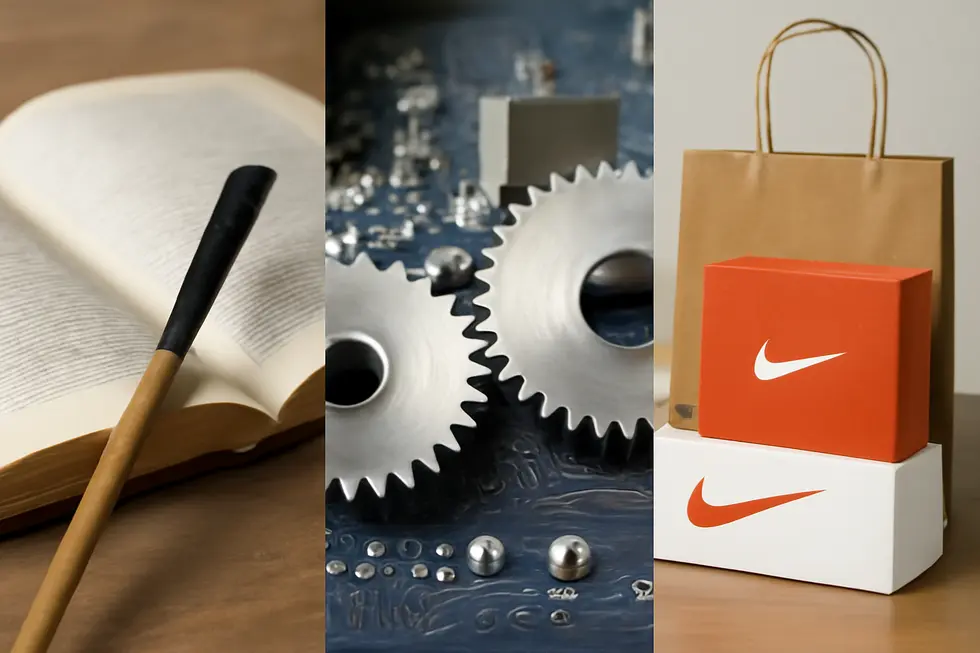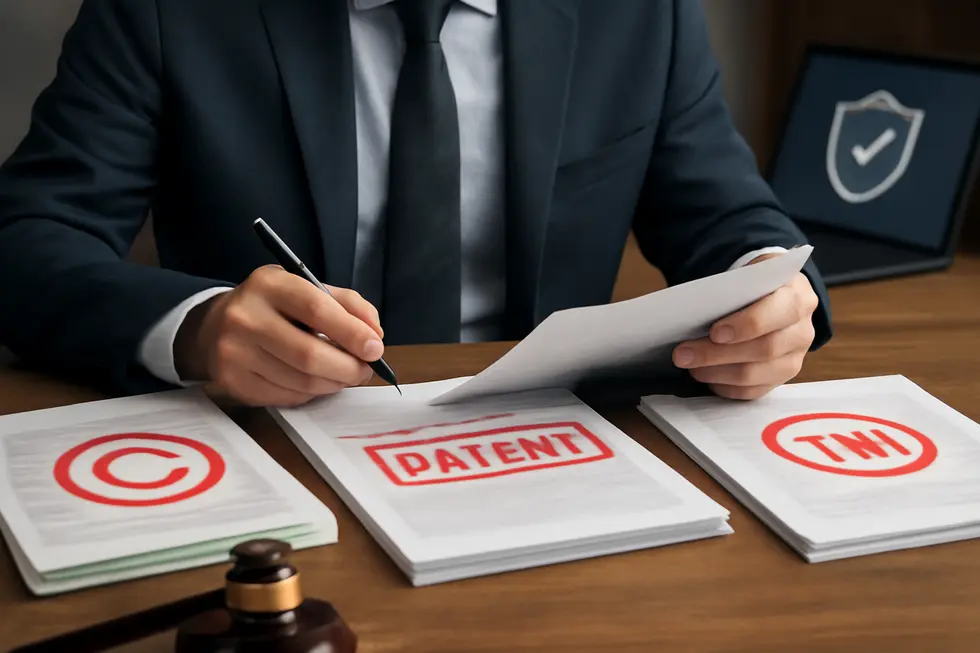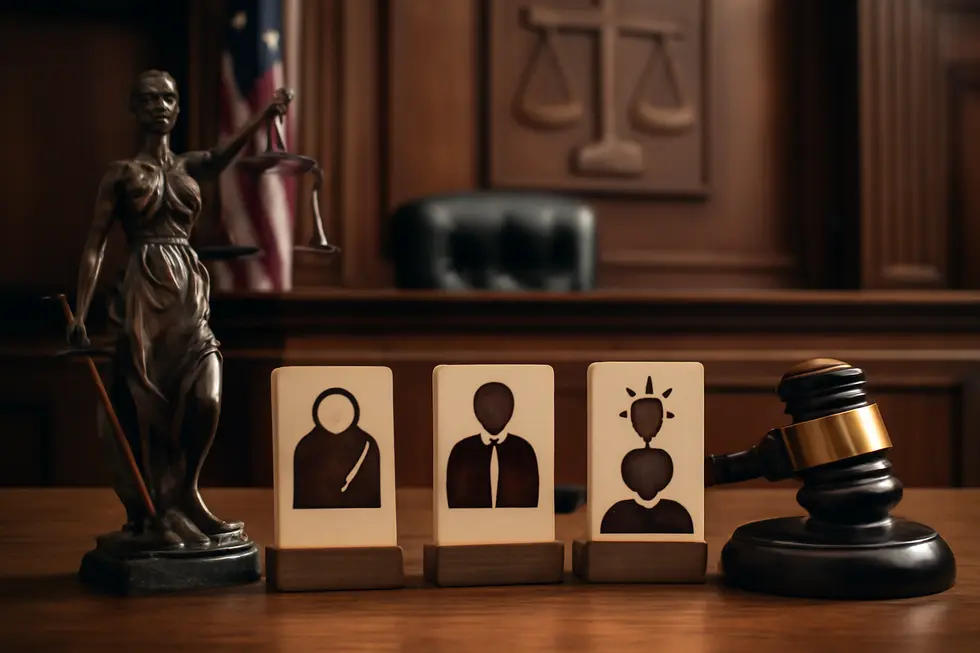Introduction
For business owners, understanding the nuances of intellectual property protection is essential to safeguard the fruits of innovation and creativity. Copyrights, patents, and trademarks each serve distinct purposes and protect different aspects of your business’s intellectual assets. Grasping their differences is crucial for making informed decisions that maximize protection and commercial value. This article breaks down these key distinctions, beginning with foundational definitions and progressing through protection scope, duration, processes for obtaining rights, economic impacts, and legal considerations. By the end, you will have a clear perspective on which form of intellectual property aligns best with your business needs.
Tables of Contents
Chapter 1: Understanding the Difference Between Copyright Patent and Trademark: Definitions and Basic Concepts
- Technological and Legal Foundations of Copyright, Patent, and Trademark Protections
- Navigating Intellectual Property: Economic Roles and Societal Benefits of Copyright, Patent, and Trademark
- Navigating Practical Uses and Global Nuances of Copyrights, Patents, and Trademarks
Chapter 2: Exploring the Key Differences Between Copyright Patent and Trademark in Terms of Protection Scope
- Distinctive Protections: Understanding What Copyright, Patents, and Trademarks Safeguard
- Duration and Legal Steps That Shape Copyright, Patent, and Trademark Protections
- Distinct Purposes and Economic Roles of Copyright, Patent, and Trademark Protections
Chapter 3: Duration and Validity: Comparing the Difference Between Copyright Patent and Trademark
- Contrasting Copyright Terms with Patent and Trademark Lifespans: What Each Protects Over Time
- How Patent Lifespan Shapes Innovation Compared to Copyright and Trademark Protections
- The Enduring Power of Trademarks: How Their Indefinite Validity Shapes Global Commerce and Society Compared to Copyright and Patent
Chapter 4: Navigating the Legal Maze: How Copyright, Patent, and Trademark Protections Are Obtained and Enforced
- Distinct Paths to Protection: Legal Procedures for Securing and Enforcing Copyrights, Patents, and Trademarks
- Navigating Intellectual Property Protections: How Copyrights, Patents, and Trademarks Differ in Acquisition and Enforcement
- Distinct Paths and Challenges in Securing and Enforcing Copyrights, Patents, and Trademarks
Chapter 5: Economic and Commercial Implications in the Difference Between Copyright Patent and Trademark
- Harnessing Intellectual Property: Distinct Economic Roles of Copyrights, Patents, and Trademarks
- Market Exclusivity and Innovation Incentives: How Intellectual Property Drives Technology and R&D Advancement
- How Trademarks, Patents, and Copyrights Shape Brand Equity and Market Position
Chapter 6: Legal and Societal Impact of the Difference Between Copyright Patent and Trademark
- Distinct Legal Foundations and Societal Roles of Copyright, Patent, and Trademark Protections
- Economic and Technological Roles Shaping the Impact of Copyright, Patent, and Trademark
- How Copyrights, Patents, and Trademarks Shape Culture and Commerce
Chapter 1: Understanding the Difference Between Copyright Patent and Trademark: Definitions and Basic Concepts

1. Technological and Legal Foundations of Copyright, Patent, and Trademark Protections
Copyright, patent, and trademark represent distinct legal mechanisms designed to protect different types of intellectual property. Copyright safeguards original creative expressions—such as books, music, films, and software code—focusing on the tangible expression rather than the underlying idea. This protection is automatic upon creation and typically endures for the author’s lifetime plus 70 years. Patents, in contrast, protect inventions or technical solutions that are novel, useful, and non-obvious, granting exclusive rights to their use and sale for roughly 20 years after filing. Obtaining a patent requires a formal, rigorous application and examination process. Trademarks secure brand elements like names, logos, and slogans used in commerce to identify and distinguish goods or services. Unlike patents and copyrights, trademarks can last indefinitely if actively used and properly renewed. Collectively, these protections address creative content, technological innovation, and commercial identity respectively, enabling creators and businesses to safeguard their assets under clear legal frameworks. For specifics on protecting creative works, see copyright information example for business.
2. Navigating Intellectual Property: Economic Roles and Societal Benefits of Copyright, Patent, and Trademark
Copyright, patents, and trademarks each play distinct yet interwoven roles in shaping economic landscapes and societal norms. Copyright protects original creative expressions, nurturing cultural growth by enabling creators to profit from their works. Patents fuel technological progress and economic vitality by granting innovators exclusive rights to recoup costly research investments, especially in critical sectors like pharmaceuticals and technology. This exclusivity, however, requires balanced regulation to maintain public access to vital innovations. Trademarks safeguard brand identity, fostering consumer trust and fair competition by preventing confusion in the marketplace. Together, these protections stimulate economic activity: patents spark innovation and job creation, copyrights sustain creative industries, and trademarks build lasting brand equity. Beyond economics, they uphold societal values—copyright encourages knowledge sharing and artistic diversity, patents advance quality of life through innovation, and trademarks ensure transparent commerce and honest consumer choice. This integrated IP framework not only rewards inventors and creators but also supports businesses and consumers, maintaining a dynamic and trustworthy market environment. For a deeper understanding of copyright’s role and benefits, visit copyright definition for business owners. More detailed explanations can be found at UpCounsel’s article on patents, trademarks, copyrights, and trade secrets.
3. Navigating Practical Uses and Global Nuances of Copyrights, Patents, and Trademarks
Copyright, patent, and trademark provide distinct protections tailored to creative works, inventions, and brand identities. Copyright shields the expression of original works like literature, music, and art, granting creators exclusive rights automatically upon creation. Patents secure inventors’ exclusive rights to novel and non-obvious technical solutions for about 20 years, but only after a rigorous application process. Trademarks safeguard brand elements—names, logos, or slogans—helping consumers identify trusted goods or services, and can last indefinitely with proper use and renewal.
These protections are highly influenced by geopolitical realities. Copyright enforcement varies internationally due to cultural and legal differences, despite efforts at harmonization through treaties like the Berne Convention. Patents and trademarks are territorial, requiring filings in each jurisdiction, with global systems such as the Madrid Protocol facilitating trademark registration, yet enforcement remains complicated by national laws and political factors. This interplay affects how rights holders strategize their intellectual property protection worldwide, balancing comprehensive coverage with cost and legal complexity.
For businesses, understanding these practical and geopolitical dimensions is essential to protect innovation, creative expression, and brand reputation effectively across borders. More details on brand protection can be explored at Trademark protection for business name and logo.
(Source: UpCounsel)
Chapter 2: Exploring the Key Differences Between Copyright Patent and Trademark in Terms of Protection Scope

1. Distinctive Protections: Understanding What Copyright, Patents, and Trademarks Safeguard
Copyright, patents, and trademarks each protect unique types of intellectual property that serve different legal purposes. Copyright focuses on original creative works, such as books, music, art, and software, safeguarding the expression fixed in a tangible form, but not the ideas behind them. This protection grants creators exclusive rights to reproduce, distribute, and adapt their work. Patents, in contrast, cover inventions and technological innovations like machines, processes, or chemical compounds. They ensure inventors exclusive rights to make, use, and sell their inventions for a set period, usually 20 years, after passing stringent criteria of novelty and non-obviousness. Trademarks protect brand identifiers, including logos, names, and slogans that distinguish goods or services in the marketplace. Their primary function is to prevent consumer confusion about product origin and maintain brand identity, with protections lasting indefinitely as long as the mark is in use and properly maintained. Recognizing these differences is essential when choosing the right protection for intellectual property, whether it involves creative content, innovative inventions, or commercial branding. For a deeper explanation of copyright’s scope, see this detailed copyright information example for business and authoritative insights on these distinctions from UpCounsel.
2. Duration and Legal Steps That Shape Copyright, Patent, and Trademark Protections
Copyright, patents, and trademarks differ significantly in how long their protections last and what legal processes are required. Copyright protection arises automatically once an original creative work is fixed in a tangible form, lasting for the author’s life plus 70 years or up to 95 years for corporate works. Registration is optional but strengthens enforcement. Patents demand a formal application demonstrating novelty and usefulness, then a rigorous examination before granting exclusive rights generally lasting 20 years from filing, with maintenance fees to keep them active. In contrast, trademarks protect brand identifiers like logos and slogans indefinitely, provided the mark is in active commercial use and regularly renewed, typically every 10 years. Trademarks require registration to achieve full legal benefits, ensuring they are distinctive enough to prevent consumer confusion. These legal distinctions reflect each intellectual property’s purpose—copyright secures creative expressions, patents safeguard inventions, and trademarks preserve brand identity. Choosing which form of protection to pursue hinges on the nature of the intellectual property and the duration and procedural demands suitable for the owner’s needs. For further insight, see comprehensive trademark protection for business names and logos. More detailed comparisons are available at ebizfiling.com.
3. Distinct Purposes and Economic Roles of Copyright, Patent, and Trademark Protections
Copyright, patent, and trademark protections serve distinct purposes, shaping their scope and economic effects. Copyright safeguards original creative expressions fixed in tangible mediums, such as books, music, or software, granting creators exclusive rights to reproduce and distribute their works. This protection encourages cultural and artistic innovation by securing creators’ revenue over an extended period, typically the author’s lifetime plus 70 years. Meanwhile, patents focus on technological advancements, protecting new, useful, and non-obvious inventions like devices or processes. They grant inventors exclusive rights for up to 20 years, fostering innovation by allowing recoverable investment in research and development. Trademarks protect brand elements—names, logos, and slogans—that distinguish goods or services, preventing consumer confusion and building lasting brand loyalty. Unlike copyrights and patents, trademark rights can persist indefinitely if actively maintained, playing a vital role in commercial identity and market competition. Grasping these nuanced differences helps inventors, creatives, and businesses select fitting protections tailored to their intellectual assets, maximizing value and safeguarding their interests. For comprehensive insights, visit ebizfiling.com.
Chapter 3: Duration and Validity: Comparing the Difference Between Copyright Patent and Trademark

1. Contrasting Copyright Terms with Patent and Trademark Lifespans: What Each Protects Over Time
Copyright protection begins automatically once a creative work is fixed in a tangible form. For individual creators, copyright lasts for the life of the author plus 70 years, ensuring long-term control over literary, artistic, and musical expressions. In cases of corporate or works made for hire, protection spans 95 years from publication or 120 years from creation, whichever is shorter. Unlike copyrights, patents safeguard inventions for a strictly limited time—typically 20 years from the filing date for utility patents, and 15 years from grant for design patents in the U.S. This finite term encourages innovation while eventually allowing public access once expired. Maintenance fees must be paid to retain patent rights during this period. Meanwhile, trademarks—covering brand names, logos, and slogans—can last indefinitely as long as they remain actively used and properly renewed, generally every 10 years. This continuous use requirement enables businesses to sustain exclusive brand identity protection, preventing consumer confusion over time. Each duration reflects these intellectual properties’ distinct goals: copyrights preserve creative expression, patents protect new inventions temporarily, and trademarks maintain lasting brand recognition. For a deeper dive into these timelines, see trademark protection for business name and logo. For an extensive comparison, refer to Dilworth IP’s guide on trademark vs copyright vs patent durations.
2. How Patent Lifespan Shapes Innovation Compared to Copyright and Trademark Protections
Patents, copyrights, and trademarks differ significantly in their duration and impact on innovation and commerce. Patents grant inventors a 20-year monopoly from filing, though effective market exclusivity often shrinks to 7-10 years, especially in sectors with lengthy development like pharmaceuticals. This limited term encourages rapid innovation while balancing public access once patents expire. In contrast, copyrights protect creative works for the author’s life plus about 70 years, promoting cultural preservation and allowing heirs long-term economic benefits. Trademarks stand apart by offering potentially indefinite protection, contingent on continuous commercial use and renewal every 10 years. This ongoing validity fosters enduring brand identity and consumer trust. The fixed patent term incentivizes investment in research but also imposes a temporal limitation on monopoly rights, shaping strategies for market entry and intellectual property management. Meanwhile, copyright’s length fuels cultural growth, and trademarks support lasting brand equity. Understanding these temporal differences clarifies how each intellectual property type balances protection with innovation and public interest. For a deeper exploration, see trademark protection for business names and logos.
3. The Enduring Power of Trademarks: How Their Indefinite Validity Shapes Global Commerce and Society Compared to Copyright and Patent
Unlike copyrights and patents, trademarks offer the unique advantage of indefinite protection, provided they are renewed every 10 years and remain in active commercial use. This continuous renewal distinguishes trademarks from copyrights—which last for the author’s life plus 70 years (or 95 years for corporate works)—and patents, which grant exclusive rights for roughly 20 years before the invention enters the public domain. The indefinite lifespan of trademarks plays a crucial role in supporting brand identity over time, enabling businesses to sustain consumer recognition and market presence without temporal limitation.
Geopolitically, this characteristic aligns with international trademark agreements that encourage cross-border commerce, enabling brand owners to confidently expand while fostering competition and economic growth worldwide. Societally, trademarks reduce consumer confusion and promote trust by protecting recognizable symbols and names, thereby incentivizing innovation tied to brand development. In contrast, the fixed terms of patents and copyrights balance exclusive rights with societal benefit by eventually broadening public access to inventions and creative works.
This fundamental difference in duration underscores distinct policy goals: trademarks maintain commercial stability indefinitely, while copyrights and patents prioritize timed incentives that foster innovation and cultural enrichment. For more on trademark protection and renewal, see trademark protection for business names and logos and further trademark details at https://en.wikipedia.org/wiki/Trademark.
Chapter 4: Navigating the Legal Maze: How Copyright, Patent, and Trademark Protections Are Obtained and Enforced

1. Distinct Paths to Protection: Legal Procedures for Securing and Enforcing Copyrights, Patents, and Trademarks
Copyrights arise automatically the moment an original work is fixed in a tangible form, such as writing or recording. While registration is optional, it strengthens legal standing by enabling claims for statutory damages and attorney fees in enforcement. Enforcement typically involves legal action against unauthorized reproductions. In contrast, patents demand a rigorous process: inventors must submit detailed applications demonstrating novelty, utility, and non-obviousness to authorities like the USPTO. Granting exclusivity lasts around 20 years, during which the inventor must actively enforce rights through lawsuits, as the government does not intervene. Meanwhile, trademark rights originate through actual commercial use but gain robust legal protection through registration. The trademark registration process includes eligibility review, examination, publication for opposition, and eventual registration if uncontested. Trademarks can endure indefinitely with ongoing use and renewal, and enforcement focuses on preventing consumer confusion caused by similar marks. These differing legal frameworks reflect the unique nature of creative expression, technological innovation, and brand identity, shaping how rights are secured and upheld. For a deeper guide on trademark protection, exploring trademark protection for business names and logos is recommended. More detailed procedural insights can also be found at the ebizfiling.com blog.
2. Navigating Intellectual Property Protections: How Copyrights, Patents, and Trademarks Differ in Acquisition and Enforcement
The journey to securing intellectual property rights varies greatly among copyrights, patents, and trademarks, shaped by their unique scopes, durations, and enforcement mechanisms. Copyright protects original creative expressions—like literary, musical, and artistic works—automatically as soon as they are fixed in a tangible form. While registration is optional, it strengthens legal claims during enforcement, which targets unauthorized copying or distribution. Patents, by contrast, guard inventions and technological innovations, requiring a rigorous application process to prove novelty, utility, and non-obviousness before granting exclusive rights typically lasting 20 years. This process involves detailed examination to ensure the invention is truly original. Trademarks distinguish goods or services through brand elements such as names, logos, and slogans. These demand both registration and evidence of commercial use, allowing protection to continue indefinitely, provided renewal and active use are maintained. Enforcement for trademarks focuses on preventing consumer confusion caused by similar marks in commerce. Understanding these distinctions empowers creators and businesses to choose the right type of protection—whether safeguarding an invention, a creative work, or brand identity. For further insight into copyright specifics, see this comprehensive resource on copyright information for businesses.
[Source: ebizfiling.com, upcounsel.com, prasaip.com]
3. Distinct Paths and Challenges in Securing and Enforcing Copyrights, Patents, and Trademarks
Obtaining and enforcing intellectual property rights varies greatly across copyrights, patents, and trademarks, each presenting unique challenges with significant economic impacts. Copyright protection arises automatically upon creating an original work fixed in a tangible form, such as a book or song, with optional registration that strengthens legal enforcement. Its enforcement targets unauthorized copying and distribution, often requiring proof of infringement and resulting in damages. By contrast, patents demand a comprehensive application process demonstrating invention novelty, utility, and non-obviousness, granting exclusive rights typically for 20 years. Enforcement tends to be costly and complex litigation aimed at stopping unauthorized use, which can also trigger economic debates about monopolistic pricing, especially in critical sectors like pharmaceuticals. Trademarks require formal registration and continuous commercial use to maintain rights. They protect brand identifiers, focusing enforcement on preventing consumer confusion caused by similar marks. Trademark disputes are frequently prolonged and expensive, reflecting the high economic stakes of brand identity, with cross-border enforcement adding further complexity. Understanding these distinct procedures and enforcement dynamics is vital to effectively securing and leveraging each form of intellectual property. For more details on protecting brands, visit trademark protection for business names and logos. External insights on intellectual property enforcement further illuminate these issues.
Chapter 5: Economic and Commercial Implications in the Difference Between Copyright Patent and Trademark

1. Harnessing Intellectual Property: Distinct Economic Roles of Copyrights, Patents, and Trademarks
Intellectual property rights—copyright, patents, and trademarks—play crucial but distinct roles in enabling economic growth by protecting and monetizing creative, technological, and brand assets. Copyright secures original creative expressions like literature, music, and software, granting exclusive rights that incentivize cultural production and allow creators to earn through sales, royalties, and licensing. Its protection, usually lasting the life of the author plus 70 years, balances creators’ benefits with public interest, enabling broad market exploitation of creative content. Patents, protecting new and useful inventions for about 20 years, encourage investment in innovation by granting inventors exclusive commercial rights. This fosters technological progress and economic development, as businesses leverage these rights to commercialize breakthroughs and recoup research investments. Trademarks safeguard brand identifiers such as logos and slogans indefinitely, contingent on continued use and renewal. By preventing consumer confusion and building trust, trademarks empower companies to monetize brand reputation effectively through marketing and licensing strategies. Collectively, these forms of intellectual property constitute a significant economic asset class, supporting innovation, cultural diversity, and commercial distinction. For a deeper understanding of copyright’s economic impact in business contexts, explore copyright definition economics business. Further insights can be found in the comprehensive overview at Wikipedia on intellectual property.
2. Market Exclusivity and Innovation Incentives: How Intellectual Property Drives Technology and R&D Advancement
Patents serve as a powerful commercial tool by granting inventors exclusive rights for about 20 years to make, use, and sell their inventions. This exclusivity provides a strong incentive for high-risk, costly research and development, as inventors can recoup investments and profit through direct commercialization or licensing. Such protections are crucial in technology sectors like biotechnology and semiconductors, where innovation leads to new markets and products. Through patent licensing, technology transfer is accelerated, allowing innovations to reach broader markets faster.
In contrast, copyrights protect creative works such as software code and digital content, offering long-lasting rights without the strict application process patents demand. While copyrights encourage expression and creativity, they provide less direct market exclusivity for inventions, limiting their role as innovation drivers compared to patents.
Meanwhile, trademarks focus on sustaining brand identity by protecting names, logos, and slogans indefinitely. This protection fosters consumer trust and competitive differentiation rather than protecting innovations themselves. Together, these forms of intellectual property form a balanced framework that encourages invention, secures creative output, and builds brand value—a synergy essential for thriving technology-driven industries.
For deeper insight into copyright’s role in business, see copyright language business owners.
Reference: Dilworth IP Guide on Intellectual Property Rights
3. How Trademarks, Patents, and Copyrights Shape Brand Equity and Market Position
How Trademarks, Patents, and Copyrights Shape Brand Equity and Market Position
Intellectual property rights play distinct roles in shaping brand equity and market differentiation. Trademarks hold a unique position, acting as core assets in building brand identity by protecting logos, names, and trade dress that foster consumer recognition and trust. This protection can last indefinitely, provided the mark is actively used and renewed, allowing businesses to sustain long-term brand value and loyalty in competitive markets. Patents, by granting exclusivity on novel inventions and technologies, enable companies to differentiate products through innovation, justifying premium pricing and reinforcing market leadership during their typically 20-year term. Meanwhile, copyrights primarily safeguard creative content that supports marketing and storytelling but exert a subtler influence on brand differentiation compared to trademarks or patents.
The economic implications reflect these differences: trademarks directly contribute to brand valuation and customer retention, patents enhance competitive advantage through innovation exclusivity, and copyrights generate revenue through licensing creative works. Recognizing these nuances helps organizations strategically manage their intellectual property portfolios to maximize commercial growth and defend market position. For further insights on trademark protections strengthening brand identity, see trademark protection for business names and logos.
Chapter 6: Legal and Societal Impact of the Difference Between Copyright Patent and Trademark

1. Distinct Legal Foundations and Societal Roles of Copyright, Patent, and Trademark Protections
Copyright, patent, and trademark protections each operate under distinct legal frameworks that define their scope, duration, and societal purpose. Copyright automatically safeguards the expression of original creative works—literary, artistic, musical, and digital—lasting the author’s life plus 70 years, encouraging ongoing cultural enrichment. In contrast, patents require rigorous evaluation to grant inventors a temporary monopoly, typically 20 years, incentivizing technological innovation while mandating public disclosure to foster progress. Trademarks arise from commercial use and registration, providing potentially indefinite protection to brand identifiers like names and logos, crucial for maintaining consumer trust and market fairness. These differing legal bases serve complementary societal functions: copyright fuels creativity, patents drive invention, and trademarks ensure reliable market signals. Together, they balance exclusivity with public benefit, promoting economic incentives while safeguarding access and consumer interests. For businesses navigating copyright nuances, understanding copyright language for business owners offers valuable insight. This legal mosaic shapes a dynamic ecosystem where innovation, creativity, and commerce coexist, each protected yet contributing to collective advancement.
2. Economic and Technological Roles Shaping the Impact of Copyright, Patent, and Trademark
Copyright, patents, and trademarks each influence society and the economy uniquely due to their distinct legal protections. Copyright safeguards original creative works, promoting cultural innovation by granting creators exclusive rights for decades beyond their lifetimes. This long-term protection motivates artistic production but also raises debates on access and fair use. Patents fuel technological growth by granting inventors temporary monopolies, typically lasting 20 years. This exclusivity encourages investment in research and development, especially in high-cost industries like biotechnology, while balancing concerns over monopolistic pricing and public access. Trademarks protect brand identifiers indefinitely, as long as they are actively used. They build consumer trust and market value by differentiating products and services, reducing confusion and fostering fair competition. These varying protections collectively drive economic growth, technological advancement, and cultural enrichment, reflecting how intellectual property laws tailor incentives to different creative and commercial needs. For a deeper understanding of copyright’s economic aspects, see copyright definition economics business.
3. How Copyrights, Patents, and Trademarks Shape Culture and Commerce
Copyrights, patents, and trademarks each play critical roles in shaping societal and cultural landscapes by defining the boundaries of creativity, innovation, and commercial identity. Copyright law encourages cultural richness by protecting original artistic and literary works, allowing creators to benefit economically while sometimes raising debates over long-term public access. Patents drive technological progress by granting inventors temporary exclusive rights, yet they may inadvertently restrict access to essential innovations, such as life-saving medications, highlighting the tension between incentive and equity. Trademarks preserve brand distinction, fostering consumer trust and fair competition, while simultaneously influencing cultural perceptions and economic power structures through brand recognition. These legal distinctions balance the interests of creators, inventors, businesses, and the public, affecting how culture evolves, how technology spreads, and how markets function. Understanding their societal impacts underscores the need for nuanced policies that promote innovation, protect cultural expression, and maintain consumer clarity without stifling access or diversity. For deeper insight into copyright’s role in balancing creator rights and public access, see copyright law and the public domain.
Final thoughts
Understanding the difference between copyright, patent, and trademark is fundamental for business owners aiming to protect their intellectual assets effectively. Each type of protection serves a unique purpose—copyright shields creative expression, patents secure technological inventions, and trademarks defend brand identity. Recognizing these distinctions empowers businesses to strategically select the right protections, maximize their commercial potential, and navigate legal enforcement confidently. By integrating this knowledge into your business strategy, you can safeguard innovations, build brand loyalty, and maintain a competitive edge in your market.
Your IP is the foundation of your success – let’s protect it together before it’s too late. We can’t wait to help you turn your ideas into legally secured assets.
About us
undefined



Thanks for sharing. I read many of your blog posts, cool, your blog is very good. https://accounts.binance.info/en-ZA/register?ref=B4EPR6J0